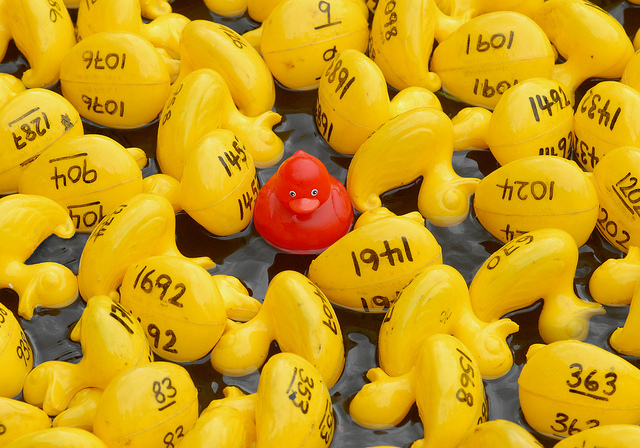Recently, I was preparing for an interview when I noticed something strange. I had lined up the websites of the company I would be visiting and its chief competitor. Looking at the two together, I could see that the competitor was using almost exactly the same language to describe its services and their value.
When I met the CMO, I asked her about this. Why was her hottest competitor using the same voice, same explanations, even the same pitch with just a few words changed? (To protect the innocent, no names are being used in this story.)
“Well, every time we come out with something, these other guys immediately copy it,” the CMO told me. “It’s frustrating but kind of flattering, actually. And, I should add, we’ve never lost a head-to-head bid with them.”
After our meeting, I crossed the competitor off my list of companies to speak to.
Dare to be yourself
This episode reminded me of the importance of setting yourself apart from your competitors in tone, in language, in value proposition – really in every way that you can. Trying to sound like anyone or everyone else is a sure path to mediocrity.
The unnamed competitor in this story was probably trying to piggyback on the first company’s success, and perhaps it can for a time. But the competitor’s inability to define its unique reason for existing ultimately sets that company up for failure. How will they convince their customers to buy if they didn’t originate the reasons for buying in the first place? Judging by the head-to-head results, they can’t.
You can write in a way that differentiates yourself while complying with any particular phrases or expectations that are special to your industry. Use the available white space to be creative.
Learning to fly
- Create differentiated taglines, phrases, and spots. What you do in 60 characters should be completely unique.
- Have a voice, style, or tone that sets you apart. Lyft is facing one of the most aggressive competitors since the Roman Empire conquered the known world (I exaggerate! Just slightly.) To set itself apart, Lyft cars are equipped with a pink mustache, a message that says the service is friendly and lighthearted. The company wants your experience to be “welcoming, affordable, and memorable”. However you feel about Lyft’s giant opponent, Lyft has used its differentiation to create a positive vibe about the alternative it offers.
- Acknowledge and separate from the pack. Suppose you provide a hosted service in an industry where a four-9s uptime guarantee is standard. Simply stating “4-9s uptime guaranteed” is not going to attract notice. But you can’t fail to mention it either, so instead write something more interesting. “We take pride in offering the best uptime guarantee possible” is better. “Our uptime is crazy!” might get even more attention. If you have to say the same thing as someone else, at least be more exciting.
- Do something unexpected with formatting or presentation. If your competition does Q&A videos, do your video as a quiz show featuring happy customers. If they have static white papers online, make yours interactive. Everyone else uses a stock photo of a woman to represent its live chat operator, and nobody really thinks that’s the person typing on the other end of the Internet. So how about representing your agent with a more creative image – a boy wizard, say, or a hobbit? Pop open a bottle and brainstorm. Even if you have a buttoned-down corporate image, you can still use technology and your imagination to go a step beyond the competition.
Vive la differénce
Often times, we think of being different as taking a risk. It’s easier to stick with the pack, to follow the crowd. Fight this temptation!
There is no simple way to measure how unique your messaging is – it is a subjective matter. If your customers can recognize your company from the particular features of your messaging, then you are being unique (unless your competitors slavishly copy you).
If you are winning awards for innovation in advertising or marketing, you are certainly being unique. But most companies don’t aim for this, and you can’t count on it even if you are.
What I do is to set down any presentation I’ve produced for 24 hours, then pick it up again and gut check myself: Do I think this is different enough to stand out? If I’ve convinced myself, I’ll ask a knowledgeable colleague to judge my work on the same standard.
Dare to be different – and you are sure to get ahead no matter how crowded the field (link: Bay to Breakers winning centipede team).
What was the most outstanding differentiated marketing you’ve encountered? Tell us about it in the comments.
PHOTO ATTRIBUTION
Dare to be different – duck race by Harry (Howard) Potts CC BY 2.0


